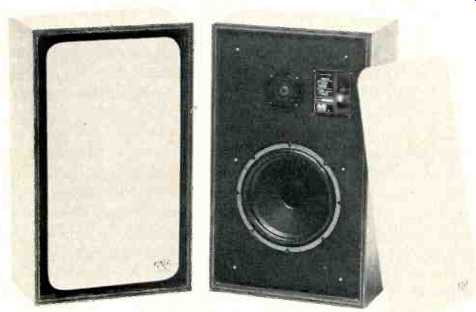
MANUFACTURER'S SPECIFICATIONS
Drivers: 1-in. dome tweeter, 10-in. high-compliance woofer. Nominal Impedance: 8 ohms. Power-Handling Capacity: 100 watts. Frequency Response: 35 Hz to 18 kHz ±5 dB. Crossover Frequency: 2200 Hz. Control: Three-position, high-frequency level switch. Dimensions: 25 in. H. x 15 in. W. x 9-5/8 in. D. Weight: 36 lbs. Price: $130.00.
The Model 102 speaker from the Avid Corp. is a two-way, air-suspension system using a one-in. dome tweeter and a 10-in. high-compliance woofer. The sides of the enclosure are finished in simulated-walnut vinyl. The dominating physical feature is the grille, which is interesting in that the user can not only change it but can select his own design. This feature alone could sell the system to many people.
The grille is a double-knit stretch fabric cut into a rectangle slightly larger than the front surface of the enclosure. The fabric is wrapped over and attached to a press-board frame, which is then snapped into the front of the enclosure. A groove in the back of the press board is used to hold the cloth by pressing the fabric into a slot with a spline.
The standard grille cloth is a dark brown, and replacement cloths are available in several other colors at $3.95 per pair. It should be noted that if one attempts to use some other piece of cloth for the grille, the original grille cloth should NOT be used as a pattern to cut the new cloth. This is because the knit fabric has been stretched during installation for a snug fit, and then trimmed close to the securing spline.
If you remove the original cloth from the grille, it might be best to get a partner to help you reinstall it, since getting a good, wrinkle-free surface can be tricky, particularly if one doesn't have experience or tools for working with splines. A changeable grille cloth is a nice feature, but allow yourself a little time to do a proper job.
A three-position tweeter-level control is available behind the removable grille. This is a slotted-shaft control that can be moved easily with a coin or screwdriver. Maximum clockwise position is minimum tweeter level. As the control is well labeled, this should not cause any confusion.
A tweeter-protecting fuse is mounted in a holder immediately above the level control. Electrical connection to the speaker is made to push-type connectors in a recessed cavity on the rear of the enclosure. The terminals are well marked and color coded.
Avid supplies a very complete instruction manual and is to be congratulated on providing intelligent and readable instructions. The speaker is covered by a five-year warranty, which is transferable to later owners.
Technical Measurements
The plot of impedance versus frequency is shown in Fig. 1. The impedance is virtually unchanged for all settings of the level control. The minimum value is low enough that parallel operation is not recommended. The characteristic of this impedance curve suggests a well-designed sealed enclosure with a 50-Hz low-frequency cutoff.
The anechoic sound pressure level at one meter for one watt drive is shown in Fig. 2. Except for a minor peak at 450 Hz, this measurement is almost exactly what Avid claims it to be in their printed operating instructions which accompany the unit. If Avid doesn't watch out, they may be cited for unwarranted honesty in specification.
Efficiency is moderate for a bookshelf system, as the Model 102 produces 85 dB SPL for one-watt average power throughout most of the usable audio range. The bottom end starts to roll off below 55 Hz and does so in a well-behaved fashion. Some mild peaks appear in the upper midrange.
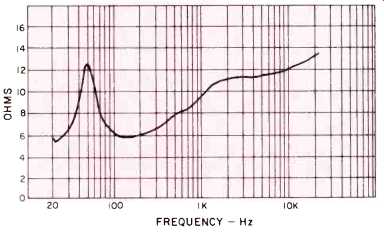
Fig. 1 Impedance.
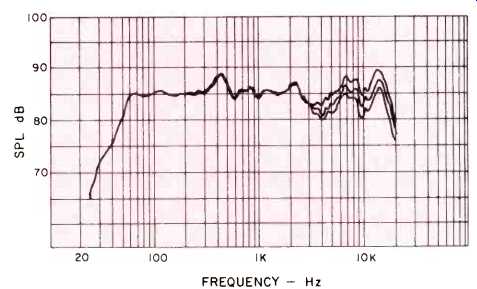
Fig. 2 Anechoic frequency response for the three positions of the balance
control.
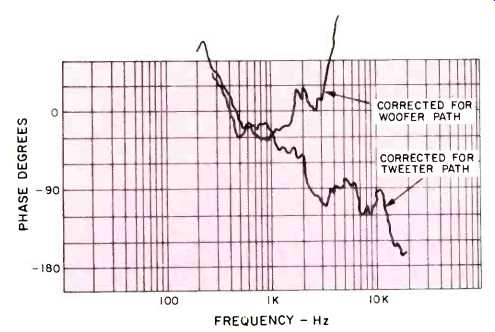
Fig. 3 One-meter anechoic phase response.
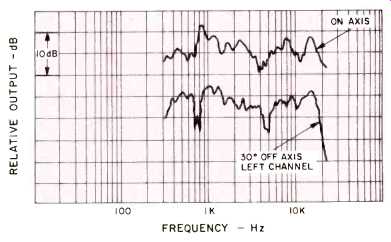
Fig. 4 Three-meter room response.
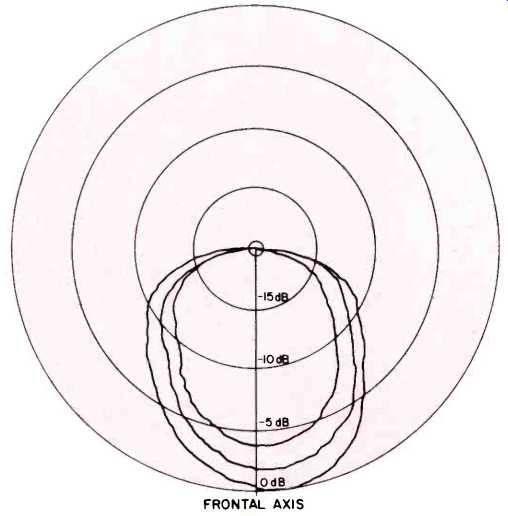
Fig. 5 Horizontal polar response.
Acoustic crossover very clearly starts at around 3 kHz, and small sibilant-emphasizing peaks are evident in the 7-to 9-kHz range and again at 14 kHz. Response, even for moderate off-axis angles, holds up well past 15 kHz. The three balance positions only affect the range above 3 kHz, and the difference between settings is very small. All in all, the response is very good for a speaker in his price range.
Figure 3 shows the phase response measured one meter directly on axis. Phase breaks occur at 500 Hz and at the 3-kHz crossover point. Because of the difference in acoustic position of the woofer and tweeter, the phase measurement is shown twice, once corrected for woofer air path and the other for tweeter air path. This speaker has non-minimum phase characteristics at 500 Hz and 3 kHz.
The three-meter room response, shown in Fig. 4, is a more direct measure of how the Avid 102 might sound in a typical listening situation. The speaker was placed against a wall and one meter above the floor. The measurement position is three meters away and also one meter above the floor. The first 10 milliseconds of "early" sound are measured and plotted for positions directly in front and 30 degrees off the center of the speaker. The plots of Fig. 4 are displaced 10 dB for clarity. The response holds up very well to 20 kHz for all normal listening positions. Since this curve was taken in the centermost of the three response-control settings, the sound is moderately strong in the upper frequencies. There is a dip in the stereo position, centered around 5 kHz, with a smaller peak in the 14 kHz region. While this extended response should be good with most program material, there are a few phono cartridges and records with high distortion levels in the upper frequencies that will show up clearly, and perhaps unpleasantly, with the 102. This situation, however, can be helped by lowering he high frequency tone control.
This occurs because of the extreme top-end response of the speaker and the minor peaks which are almost periodic on a logarithmic frequency basis and thus might emphasize higher order harmonics of an already distorting program. This characteristic will also tend to emphasize record background noise to some extent.
Figure 5 is the polar response for all components from 20 Hz to 20 kHz and is a view looking down on the top of the speaker when mounted as Avid recommends. Plots are included for each of the three equalizer positions. The difference in energy between the control settings is approximately 2 dB. According to this plot, a left-channel-stereo speaker position will be slightly stronger than the right-channel position if the speakers were rotated toward the listening area.
Since the polar response becomes equal for angles greater than about 30 degrees, these speakers should be mounted flat against a wall for best stereo imagery.
Figure 6 is the vertical polar response. These speakers should be mounted at or below normal listening level for best sound, because a large ceiling reflection can be expected due to the high launch angle of the sound, as can be seen in the chart.
Harmonic distortion for the musical tones of E1 (41 Hz), A2 (110 Hz), and A4 (440 Hz) is shown in Fig. 7. The distortion is very low at moderate and low listening levels. The lowest register runs out of steam at levels in excess of 20 watts average. Midbass and upper frequencies can be handled up to 100 watts with no difficulty. An interesting property is the drop in third harmonic of A2, i.e. E4 (330 Hz), as well as the very shallow increase in all partials above B2.
Acoustic intermodulation of A4 by E1, or 440 Hz by 41 Hz, is plotted in Fig. 8. The major contribution to this distortion is phase modulation. The crescendo handling test was passed easily. The Model 102 can handle random peaks up to 300 watts without suppressing inner musical voices more than 1 dB.
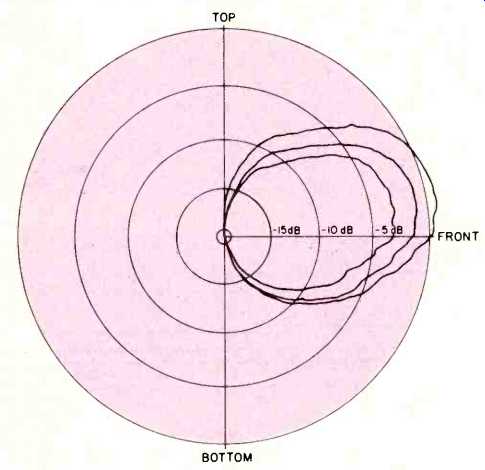
Fig. 6 Vertical polar response.
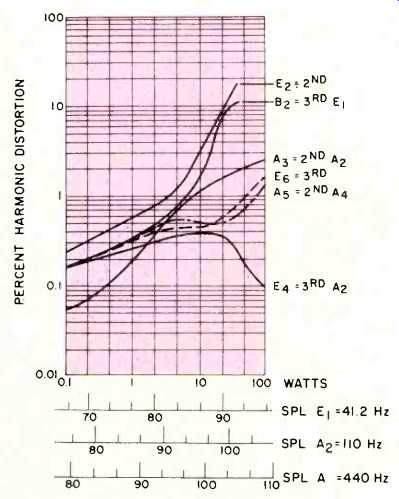
Fig. 7 Harmonic distortion for musical tones El or 41 Hz, A2 or 110 Hz,
and A4 or 440 Hz.
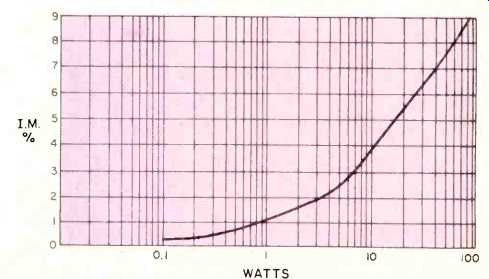
Fig. 8 IM distortion of A4 or 440 Hz by E1 or 41 Hz mixed one to one.
The energy-time response of the Avid 102 is shown in Fig. 9. Since the 102's tweeter response is so excellent, a detailed explanation of this chart can be made to aid in understanding the energy-time measurement. What is shown in this chart is a plot of time on one scale, while on the other is the magnitude of the impulse response for a perfect signal containing only components from 20 Hz to 20 kHz. This plot is related to the impulse response in the same manner as the SPL measurement of Fig. 2 is related to the complete frequency response. The energy-time curve is computed from the one-meter anechoic frequency response and covers the time from just before receipt of the first sound to a period two mS after. The major contributor to this measurement is the tweeter, which handles a wider frequency range than does the woofer. The peak at 2.9 mS is the direct sound from the tweeter. The subsidiary peaks at around 3.1, 3.2, and 3.3 mS are reverberant signals due to scatter from the tweeter-mounting structure. The logarithmic decrease of these peaks, shown as a constant dB per time, is further indication of reverberation species. The broad irregular peak from 3.3 to 3.6 mS is diffraction from the physical loudspeaker enclosure. The peak of this diffraction occurs at 3.4 mS and is due to sound reradiating from the top edge of the enclosure. Tweeter sound scattering from the woofer surface discontinuity causes the irregular diffraction at 3.8 mS, and the energy at 4.3 mS is due to sound scattering from the bottom of the enclosure. Comparison of this data with the SPL data of Fig. 2 reveals that most of the response irregularities above 2 kHz are due to sound scattering from the enclosure and not due to tweeter problems.
The 10-dB difference between direct and first reverberant sound 0.1 mS later translates to about 3 dB frequency response irregularity at 10 kHz, which is consistent with measurement. Reverberant sound due to the speaker enclosure that is 14 dB down can give rise to 2 dB variations with a major influence at slightly above 2 kHz.
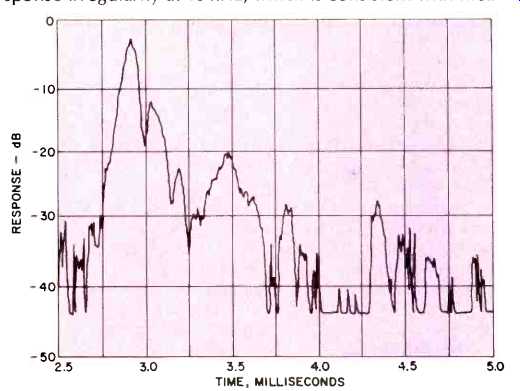
Fig. 9 Energy-time response (see text).
Listening Test
The Avid speakers were mounted against a flat wall at ear level for the listening test. Spacing between speakers was around three meters.
The top end, of the Avid 102 is quite good and appeared stronger than the midrange and bottom end, which are handled by the 10-in. woofer. In attempting to achieve the best balance of overall sound, this reviewer lowered the high frequency level both with tone controls and with the Avid's tweeter level control.
There was no boom to mar the performance of the bass end, though percussive bass, such as tom-tom and kick drum, seemed a bit thin. However, a mild bass boost with tone controls would probably bring the sound up to the standard of many listeners. The mid-bass seemed to have some mild peaks, a slightly "grainy" sound in a frequency range which can emphasize record scratches and ticks.
Stereo imagery is very good with no "wandering minstrels" caused by moving from one sitting position to another. Super brass (Lincoln Mayorga's Vol. III direct-transfer disc on Sheffield) had clear overtones but the fundamentals are not completely realistic. Vocals sound reasonably accurate if a bit distant, and massed choral groups come over well.
The Avid Model 102 puts out a lot of good sound for a rather modest price tag. As such, it can be recommended as a primary system for those on a modest budget. In addition, it can make an excellent preliminary investment for those wishing to go on to four-channel since the Model 102 with its good upper frequency characteristics can serve well in the important rear-channel positions.
-Richard C. Heyser
-----------
(Audio magazine, Sept. 1975)
Also see:
Avid Loudspeakers (ad, Sept. 1975)
AR (Acoustic Research) loudspeakers (ad, Jan. 1978)
= = = =